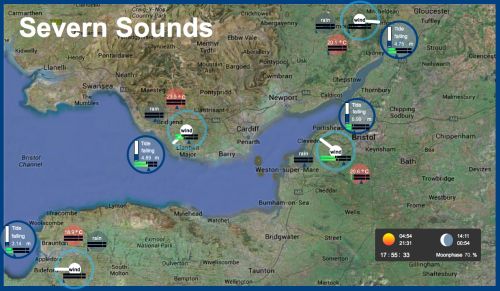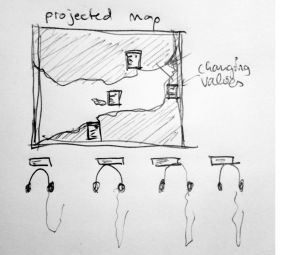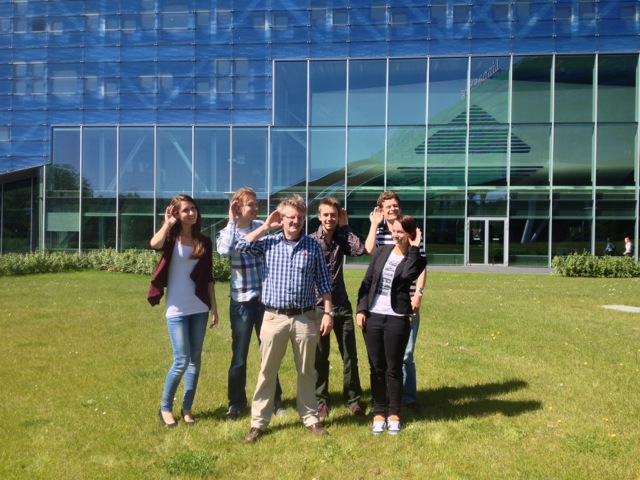Sound experiences


Monday 1st- Tuesday 2nd of July
Michaela Palmer, Digital Arts, University of the West of England- Severn Tide Sonification
This sound experience features a live sonification of tidal and weather data from the estuary. The changes in the data are visualized and made audible in (almost) real-time. There will be four “listening stations” of locations in the Severn Estuary in form of stereo headphones, one per location. Tidal differences and site-specific phenomena can be perceived by listening and by observing data change in the projection interface.
-------------------------
Monday 1st- Wednesday 3rd of July
Students from the Institute of ArtificiaL Intelligence and Cognitive Engineering (ALICE) of the University of Groningen- Sound experiment 'Measuring subjective qualities of sound'
Sound and Emotion are intimately related. The Institute of ArtificiaL Intelligence and Cognitive Engineering (ALICE) of the University of Groningen works on models of human sound appraisal that are able to predict the typical moods that people associate with sonic environments. Moods reflect our overall attitude towards the world and are as such highly relevant to geography. Compared to emotions, moods are less specific and miss the intentionality (directedness to a particular state of affairs) that characterizes emotions.
During the conference we ask you to participate in a unique experiment in which we train, in the course of the conference, a system that can predict the average of the response of the participants to city sounds. During the experiment, which takes a 10 minutes or so per participant, we ask you to indicate, with a joystick, the degree to which you deem the sonic environment pleasurable and eventful. During the last session of the conference we will demonstrate how well (or poorly) our system is able to predict the average “conference appraisal” of these sounds.
For background info see: sound_experiment_ai.pdf
Students work under supervision of Dr. Tjeerd C. Andringa, associate professor Sensory Cognition, University of Groningen
--------------------------------

Monday 1st- Wednesday 3rd of July
Radio Mobi - Sound plants
Radio Mobi will create a special sound environment in the Harmony-canteen during lunch. They will provide ‘sound plants’ for our conference with sounds collected throughout the province of Groningen. Radio Mobi will also contribute to the exhibition on ‘the Geography of Waiting’ at the University Museum.
The members of Radio MOBi consist of: Rik Möhlmann , Bert Scholten, Natasha Taylor, Joachim de Vries en Marcel de Vries.
www.wijzijn-radio.mobi
---------------------------
Monday 1st of July
Welcome reception at the Martinichurch
During the welcome reception, you will experience the sound of the church's historic pipe organ. The sound- brought to you in the form of film music played by Eeuwe Zijlstra- can be felt differently in different places in the church. More information about this event will follow.
------------------
Wednesday 3rd of July
Louisa Fairclough & Christine Felce , Artists Artist- Body of Water
During the lunch break, at 12.15 you are invited to lie down, close your eyes and listen to a n analogue field recording of the Severn Bore made at night on 1st March 2010. Duration: 11 minutes.
The Severn Bore is a tidal surge that sweeps up the estuary of the River Severn. At the time of the equinoxes, the bore is at its highest and roars along the river, swelling up and over the river’s banks. There are two main events you can hear in this recording: one is the surge of the tidal wave along the river, the second is the ringing of church bells in the distance which are swallowed by the immense noise of the wave. Around this are the details: a dog barking in the distance, something that sounds like a helicopter (but wasn’t), the glop and gurgle of the water as it rises up the muddy bank.
Louisa Fairclough is an artist using tidal water, voice and light as material. Following her sister's death, she returned time and again to sleep on the banks of the River Severn to make a body of work that both describes her experience of grief and also formed the beginnings of a notional collaboration with her deceased sister. The artist will talk further about her work on Tuesday afternoon as part of Consolation-scapes: Analysing grief and consolation between space and culture (Session 4).
(We recommend you either grab your lunch before as a take away version, or on your way back to sessions afterwards)
-----------------
Wednesday 3rd of July
Conference party
The conference party will feature 70s (and soul) cover band BURN (http://www.music-burn.nl) ... plus a DJ
